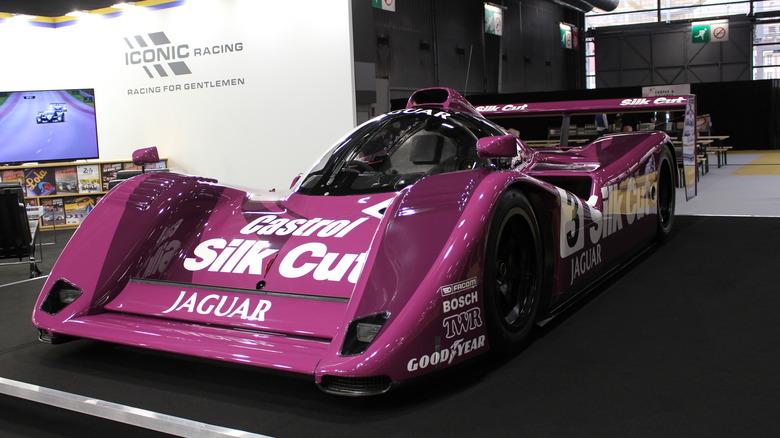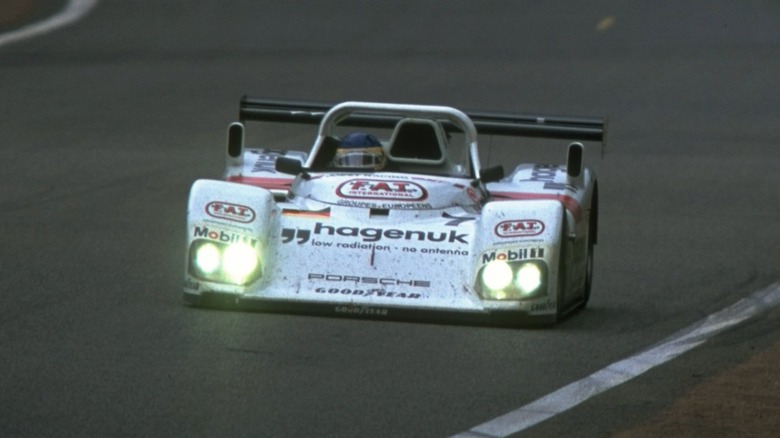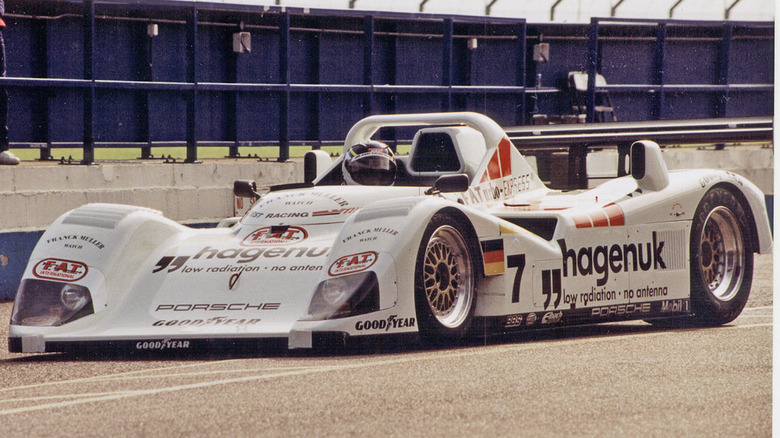The Innovative Jaguar Race Car That Transformed Into A Le Mans Winning Porsche
In these days of mighty mergers, it's not all that unusual that a Peugeot, Chrysler, and Jeep might all arise from the same company. Perhaps it's no longer surprising that, over the course of its operational history, a single car could be comprised of Jaguar, Mazda, and Porsche.
Even in the era of the automotive multinational, that doesn't seem like it would make any sense. Porsche and Jaguar are stalwart champions of two conflicting design philosophies, repping less-is-more performance and more-is-more luxury, respectively. Neither automaker even belongs in the same conversation as the sensible, reliable Mazda.
Such are the circumstances of high-level motorsports, however. The XJR-14, a serious achiever in both Group C racing, and endurance tests like Le Mans, wore the colors of all three of those storied automakers at one time or another. The adventures of the many-branded XJR-14 were equal parts racetrack politics, financial pressure, and engineering achievement.
Win races, make money, how hard can it be?
The saga of the XJR-14 begins with Tom Walkinshaw Racing. The widely honored engineering firm built the XJR-14 in 1991 on contract with Jaguar. According to reporting in Petrolicious, Jaguar wanted a 3.5-liter performer that would match the evolving requirements of Group C racing at the time. The result was fearsome: With a carbon fiber monocoque design built over a screaming V8 putting out 650 horsepower, the XJR-14 blasted past older competitors to win multiple championships in the World Sports Cars race series.
It had already begun to struggle, however. The XJR-14 struggled to find wins during the 1992 season; the stiff, unforgiving build had particular trouble on uneven American tracks. Rather than modifying the design, Jag simply withdrew its sponsorship.
Most racing stories would end here. A thoroughbred race car would have a brief window of triumph before relentless improvements in engineering left it in the dust. Tale as old as time, until Mazda came along.
Victory at the end
Mazda bought the XJR-14 with a whole new plan: endurance racing. The Japanese company put the ex-Jaguar on the road at Le Mans, and while it didn't win, it held its own. Unfortunately, Mazda stepped away from racing entirely not long afterward, but that did not ring the death knell for the XJR-14.
Porsche decided to hop in and take over, and there was no danger of Porsche motorsports abandoning racing or leaving their new acquisition behind. The German automaker gave the XJR-14 — now going by the mouthful name of "TWR-Porsche WSC-95" — a full makeover, complete with an open cockpit and a classic Porsche flat-six engine.
It was in this configuration that the ex-Jaguar, ex-Mazda battler finally found the victory it had been searching for. It hit the Holy Grail of endurance racing not once, but twice, winning Le Mans in 1996 and 1997. Porsche would retire the car in 1998. Legendary racing driver Martin Brundle once described the vehicle aptly, via Motor Sport Magazine:
"The XJR-14 stuck to the ground, gave you confidence, did everything it was supposed to do and was an absolute pleasure to drive."


